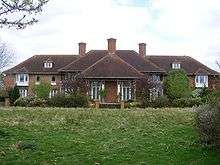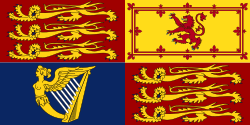Sunninghill Park
Sunninghill Park was a country house and estate of about 665 acres (2.7 km2; 1.0 sq mi) directly north of Cheapside, in the civil parishes of Sunninghill and Ascot and Winkfield, adjoining Windsor Great Park in the English county of Berkshire.
The early 19th-century house burned down in 1947 and a replacement was built in the grounds during the final years of the 1980s to be the official residence of the Duke of York from 1990 until 2004; it was sold in 2007 to Timur Kulibayev for $19.7 million which was $4 million more than the asking price.[1] The house fell into disrepair and was demolished in 2016.[2]
First house
Sunninghill Park was originally part of Windsor Forest until 1630, when King Charles I granted it to Thomas Carey.[3] Around 1633, it was purchased by Sir Thomas Draper and sold in 1769 by his great grandson, Thomas Draper Baber, to Jeremiah Crutchley, whose family owned it until it was sold in 1936 by Percy Edward Crutchley (whose maternal grandparents were the owners of Eldon House in London, Ontario).[4][5] The first significant house was built on the estate in the late Georgian period in the early 19th century, being a stucco building of two stories with later additions.[6]
It served as the headquarters of the American Ninth Air Force from November 1943 to September 1944. The Crown Estate Commissioners purchased the property from Philip Hill in 1945. The main house was to be occupied by Princess Elizabeth (later Queen Elizabeth II) and her future husband, Prince Philip, Duke of Edinburgh, after their wedding in November 1947. However, the house burned down on 30 August 1947 before their wedding, so they rented Windlesham Moor instead.[7] In the mid-1960s, the site was considered for a new home for Princess Margaret.
Second house


In 1986,[8] the walled garden of 5 acres (20,000 m2) was purchased from the Crown Estate Commissioners on behalf of Queen Elizabeth II. The following year, construction began on a two-storey red brick house to be the home of the Duke and Duchess of York. The architect responsible was Sir James Dunbar-Nasmith, Balmoral Estate Architect and Professor at Heriot-Watt University.[9] Construction was completed in 1990.
The house had six reception rooms, 12 bedrooms, and 12 bathrooms, comparable in size to most larger UK instances built since World War II. It was the first newly built royal home since Bagshot Park, which was built in 1879 for the Duke of Connaught. In the British tabloid press, the home was often referred to as 'SouthYork', a play on words for the 'Southfork' estate on the popular 1980s soap opera Dallas'. It was also "mocked for its resemblance to a Tesco-style supermarket".[9]
Following the death of Queen Elizabeth The Queen Mother in 2002, it was announced that the Duke of York was to be designated her former home Royal Lodge, Windsor instead.[10] The Duke of York and his former wife shared the family's home until 2004, when he moved to the Royal Lodge, the refurbishment of which was funded by taking out a mortgage on Sunninghill Park. The Duchess of York moved out in 2006.
Its legal title records that the house and some of its grounds were sold for £15 million in 2007, £3 million over the asking price, to an offshore trust in the British Virgin Islands.[9][11][12] Kenes Rakishev, a 29-year-old Kazakh businessman who called himself a 'friend' of Prince Andrew, professed to have negotiating the deal with the help of his father-in-law Imangali Tasmagambetov, the mayor of Astana, but insisted neither of them was the owner.[9] Later, the owner was revealed to be Timur Kulibayev, the billionaire son-in-law of the Kazakh president, Nursultan Nazarbayev.[9] Kulibayev acknowledged ownership after a newspaper investigation revealed he had used offshore companies and a trust to make the purchase.
The house fell into an increasing state of disrepair. By 2009, it had "doors hanging open, weeds sprouting through the terrace paving, windows broken, grass growing through the cover over the empty swimming pool, peeling paintwork and a general air of dereliction."[13] In July 2009, Bracknell Forest Borough Council were said to be considering seizing the property under the Housing Act 2004 and using it as a homeless shelter, following several reported break-ins.[14] In 2013 the owner was granted planning permission to demolish it and replace it with a larger house, and in 2014, photos showed the former royal home appeared to be seriously dilapidated. Demolition was temporarily halted when more than 100 bats were found roosting under its roof,[15] before its actual demolition.[2]
References
- Coughlin, Daniel (January 30, 2020). The Crumbling Abandoned Mansions of the Rich and Famous: Prince Andrew and Fergie's Dallas Palace (slide #25). lovemoney.com website. Retrieved June 18, 2020.
- "Queen's wedding present to Prince Andrew is flattened". 18 April 2016.
- "RBH: History of Sunninghill, Berkshire". www.berkshirehistory.com. Retrieved 19 March 2019.
- Robin and Terry Harris, eds. The Eldon House Diaries: Five Women's views of the 19th century Toronto: Champlain Society, 1994, page 343.
- "Sunninghill Park". berkshirehistory.com. Retrieved 10 May 2018.
- Ditchfield, P. H.; Page, William, eds. (1923). "Sunninghill". A History of the County of Berkshire: Volume 3. pp. 134–136.
- "Surrey home for princess". The Canberra Times. 8 January 1948. p. 1. Retrieved 4 July 2010.
- Prince Andrew's £15million former royal residence could be seized and used for the homeless Daily Mirror
- Foggo, Daniel; Swinford, Steven (27 July 2008). "Prince Andrew, his £15m home and the Kazakhstan connection". The Sunday Times. London. Retrieved 4 July 2010.
- "Will of Queen Elizabeth The Queen Mother". The Royal Household. 17 May 2002. Retrieved 4 July 2010.
- Bates, Stephen (1 March 2009). "From royal fairytale to crumbling eyesore: the mystery of Prince Andrew's old home". The Guardian. London. Retrieved 4 July 2010.
- Mendick, Robert; Alderson, Andrew (30 May 2010). "Prince Andrew and the Kazakhstan connection". Daily Telegraph. London. Retrieved 4 July 2010.
- Stephen Bates, From royal fairytale to crumbling eyesore: the mystery of Prince Andrew's old home, Guardian (March 1, 2009).
- Boniface, Susie (19 July 2009). "Exclusive: Prince Andrew's £15 million former royal residence could be seized and used for the homeless". Daily Mirror. Retrieved 4 July 2010.
- Tom Sykes (17 March 2016). "Prince Andrew's House—and Old Royal Life—Lies in Ruins". The Daily Beast. Retrieved 21 May 2016.

.svg.png)